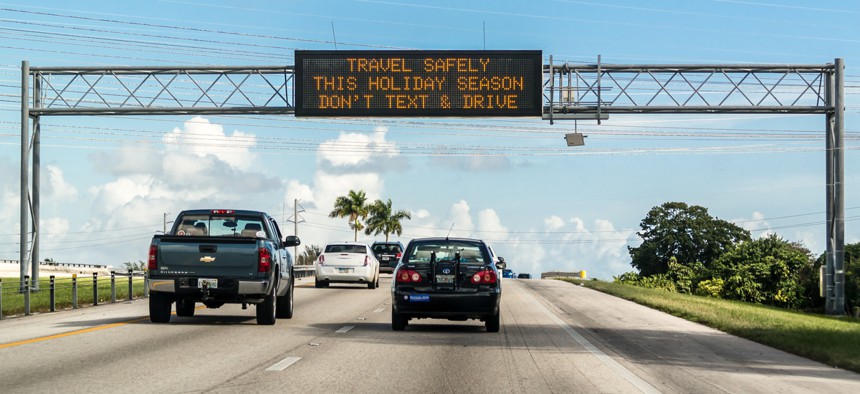States Where You’re Most Likely to Be Texting While Driving

Electronic variable message board on matrix billboard on highway warning drivers not to text and drive. Shutterstock
And iPhone users are the worst offenders.
For a country that loves its cars, Americans seem to love phones even more. The combination most of all.
Zendrive, a driver safety and analytics app, has analyzed data from its 4.5 million users to assess how much distracted driving is happening on U.S. roads. They found the number of people who text, scroll, or otherwise fiddle with their phones while behind the wheel is increasing in every city and every state (except Vermont), along with the amount of time they spend doing so.
Most of this use happens at the start of the trip, but Zendrive estimates more than 60% of drivers check their phones while driving and use the phone for average 1-minute, 52 seconds per hour. Even that undercounts the time. Once you remove people who don’t check their phones at all, the average use time rises to three minutes and 40 seconds per hour (iPhone users were the worst offenders).
That has consequences. The risk of death or injury increase every second drivers’ eyes are away from the road. The National Highway Transportation Safety Administration estimates that 3,477 deaths and 391,000 injuries were the result of distracted driving in 2015 alone (that’s not all from activities like texting, but it names that the most “alarming” cause). Are there any legitimate reasons for using the phone under these conditions? “No, this is dangerous,” Jonathan Matus, wrote founder and CEO of Zendrive by email. “The research and recent increase in traffic deaths proves this.”
Distracted Driving Rankings
Zendrive created a ranking for U.S. cities states based on the frequency and duration in which drivers used their phone while driving for various purposes such as talking, texting, or navigating. The company collected anonymized data from its smartphone app from 4.5 million drivers who traveled a collective 7.1 billion miles between December 2017 and February 2018. It counted times when the driver was manipulating their phone in their hand as the car was moving (although it did not note how often this was at high speeds versus being stuck in traffic).


Michael J. Coren writes for Quartz, where this article was originally published.

NEXT STORY: Q&A: Cities Must Look at Education 'Beyond the Schoolhouse Doors'





